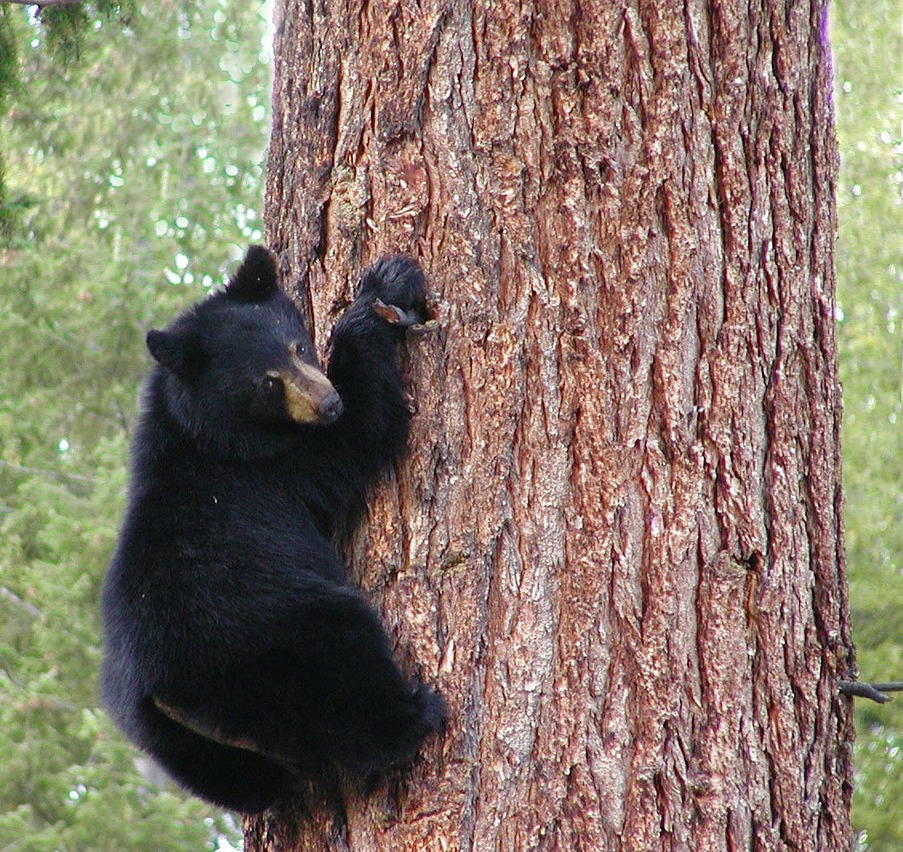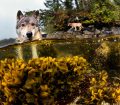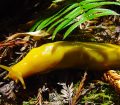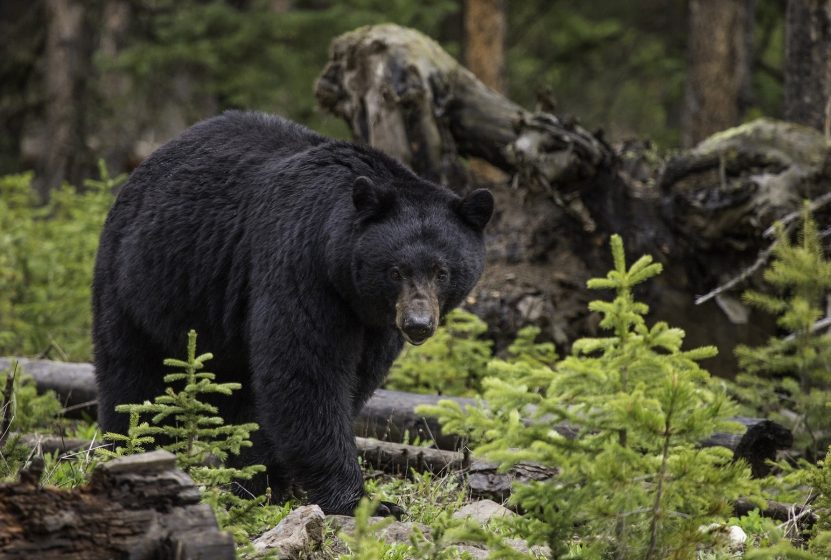The American black bear (Ursus americanus) is North America’s smallest and farthest ranging species of bear, after the grizzly bear and polar bear. Despite its name, the black bear’s coat comes in a variety of colors such as brown, blue-grey, and even white.
The black bear is between 4-7 feet long from nose to tail, and 2-3 feet high at the shoulder. Females weigh between 90-300 pounds and males between 125-500 pounds.
The American black bear can be found at least in at least 40 U.S. states. Eastern populations typically have black fur while western bears may have brown and blond hair. Black bears with white hair are known as Kermode (glacier) bears, or Spirit Bears, and only inhabit coastal British Columbia, Canada.
An estimated 600,000-800,000 black bears are living in North America with 340,000-460,000 residing in the United States. Historically, black bears lived in nearly every forested region in North America but have moved away from areas of dense human population. In Canada, the black bear still inhabits most of its historic range, but is now only found in a few small pockets in Mexico’s mountainous regions.

The black bear is omnivorous and will eat just about anything: fruits, insects, honey, plants, nuts, small mammals, and even young deer or moose. Black bears are also notorious dumpster divers and will raid garbage cans, coolers, and bird feeders.
Compared to a human, the black bear has better eyesight and hearing. The bear’s sense of smell is about seven times greater than a domestic dog’s, enabling it to smell your campfire stew from a mile away.
The black bear has curved, fixed claws 1-2 inches long which make it an excellent tree-climber. It also uses its claws to mark trees as a form of communication with other bears.

The black bear is an outstanding swimmer and can cover distances up to 1-½ miles in freshwater. It can also run at speeds at up to 30 mph.
In general, the black bear is a solitary animal. It will, however, forage in groups if there is a plentiful supply of food, like a salmon spawn, in one area.
A female black bear’s home range is 2-10 square miles while the male black bear lays claim to an area anywhere from 10-59 square miles.
The black bear also hibernates in the winter months depending on weather and food availability. During hibernation, the bear’s heart rate drops from an average resting heart rate of 40-50 beats per minute to eight beats per minute.
The length and depth of hibernation match the regional norms of food availability with more prolonged and deeper hibernations in northern climates. When the bear has access to a stable food supply and warm weather, it will not hibernate.

The black bear mates in the summer and will give birth in December and January. The litter size ranges from one to six cubs, with two being the most common. The cubs will remain with their mother for at least 18 months.
The black bear can live up to 39 years in the wild with an average lifespan of 18 years. Very few adult bears die of natural causes or disease. Most adult black bears will die from human-related events such as hunting or getting hit by cars.
To American indigenous peoples, the black bear is a symbol of great reverence. To some tribes, the black bear was a creation of the Great Spirit while the grizzly bear was a creation of the Evil Spirit.
The Ojibwe tribe in the northern Midwest tells the story of a great forest fire along Lake Michigan’s western shore that forced a mother black bear and her two cubs into the lake. Due to the arduous swim, the cubs fell behind. When the mother bear reached the Michigan shoreline, she waited on top of a bluff for her cubs to arrive. They never did. The winds eventually buried her under the sand where she still waits to this day for her cubs. Those dunes are now called the Sleeping Bear Dunes National Lakeshore.
Although black bears are not typically aggressive toward humans, there are a few precautionary steps you should take if you are hiking and camping in bear country. After all, the black bear doesn’t want to be surprised by running into you either.
Avoid hiking when bears are most active: dawn and dusk. If you spot a bear in the distance, stop and give it space.
When moving away from a bear, do not turn your back to it. Showing your back indicates you are prey. This may lead to an unpleasant experience.
Brush up your tracking skills and learn what bear tracks and scat look like. If you see signs of bear, stay on the alert.

Store your food, trash, cookware, and personal hygiene products (like toothpaste and feminine products) in a bear canister or tree bag. Many campsites in bear country will provide a metal food locker. Use that instead of your car unless you want to find out what a bear will do to get food. You may also want to lock away the clothes you used to cook in.
If you meet a bear on the trail or going through your campsite trash, slowly back away while talking in a calm voice. Consider telling the bear your favorite “So, a bear walks into a bar…” joke.
When the black bear wants you to back off, it will make warning sounds that include lip-popping and jaw-clicking. When the bear becomes more aggressive, it will make a deep-throated pulsing sound to indicate it is less than happy with you. This is a surefire indication your bear joke was a dud.




